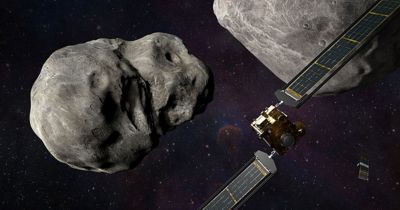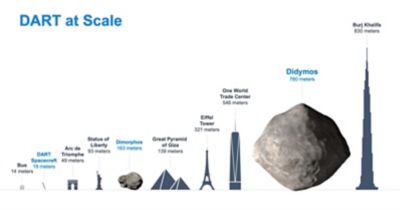-
-
학생용 무료 소프트웨어에 액세스하기
차세대 엔지니어에게 힘을 실어주는 Ansys
학생들은 세계적 수준의 시뮬레이션 소프트웨어를 무료로 이용할 수 있습니다.
-
지금 바로 Ansys에 연결하십시오!
미래를 설계하기
시뮬레이션이 다음 혁신을 어떻게 지원할 수 있는지 알아보려면 Ansys와 연결하십시오.
국가
무료 트라이얼
제품 및 서비스
학습하기
회사 정보
Back
제품 및 서비스
ANSYS BLOG
November 4, 2022
How the Double Asteroid Redirection Test (DART) Hit a Bullseye
Anyone who has played darts knows that it takes some skill to hit a bullseye. You have to account for trajectory, speed, distance, and any anomalies that might stop the dart from flying true. Now imagine if the dart was the size a bus and the bullseye was seven million miles away — and moving.
On November 24, 2021, NASA and the Johns Hopkins Applied Physics Laboratory (APL) took that shot, hitting a bullseye 10 months later on September 26, 2022. The Double Asteroid Redirection Test (DART), a joint project between NASA and APL, sent a spacecraft hurtling through space at roughly 14,000-miles per hour (22,530-kilometers per hour) to hit an asteroid measuring about 525 feet (160 meters) in width.

Illustration of NASA’s DART spacecraft and the Italian Space Agency’s (ASI) LICIACube prior to impact at the Didymos binary system. Credit: NASA/Johns Hopkins APL/Steve Gribben
Commonly referred to as Earth’s first planetary defense test mission, DART aimed to test the kinetic impactor theory to determine if it was possible to change the orbital period of Dimorphos around Didymos, a pseudo-stable binary asteroid system. What does that mean? A slightly simplified and imperfect explanation is that Dimorphos is a moonlet that “orbits” the larger Didymos. The objective was to determine if it’s possible to change Dimorphos’ speed by the slightest amount. In the event of an asteroid bound for Earth, this nudge could mean the difference between a direct hit and a near miss.

These images, from the Hubble Space Telescope on the left and the James Webb Space Telescope on the right, show observations of the Didymos-Dimorphos system several hours after NASA’s Double Asteroid Redirection Test (DART) intentionally impacted the moonlet asteroid. Credit: Science: NASA, ESA, CSA, Jian-Yang Li (PSI), Cristina Thomas (Northern Arizona University), Ian Wong (NASA-GSFC); image processing: Joseph DePasquale (STScI), Alyssa Pagan (STScI).
“DART is turning science fiction into science fact and is a testament to NASA’s proactivity and innovation for the benefit of all,” said NASA Administrator Bill Nelson in a press release. “In addition to all the ways NASA studies our universe and our home planet, we’re also working to protect that home, and this test will help prove out one viable way to protect our planet from a hazardous asteroid, should one ever be discovered that is headed toward Earth.”
To be clear: Neither Dimorphos nor Didymos posed any hazard to Earth before or after DART’s controlled collision with Dimorphos.
Prior to DART’s impact, it took Dimorphos 11 hours and 55 minutes to orbit its larger parent asteroid, Didymos. Since DART’s intentional collision with Dimorphos on September 26, astronomers have been using telescopes on Earth to measure how much that time has changed. Now, the investigation team has confirmed the spacecraft’s impact altered Dimorphos’ orbit around Didymos by 32 minutes, shortening the orbit to 11 hours and 23 minutes. This measurement has a margin of uncertainty of approximately plus or minus two minutes.

Everything is relative. The size of DART and its target — the asteroid Dimorphos — relative to objects on Earth Credit: NASA/Johns Hopkins APL
“DART has given us some fascinating data about both asteroid properties and the effectiveness of a kinetic impactor as a planetary defense technology,” said Nancy Chabot, the DART coordination lead from APL in Laurel, Maryland, via a press release. “The DART team is continuing to work on this rich dataset to fully understand this first planetary defense test of asteroid deflection.”
Confidence Through Simulation
This early mission planning performed by Johns Hopkins APL relied extensively on Ansys Systems Tool Kit (STK). The formulation of DART’s trajectory to the double-asteroid system was largely planned using STK, and the team continued to use STK to visualize relevant vectors and attitude throughout the mission-planning process. The thermal team appreciated STK’s full mission environment when checking the location of the Sun relative to the satellite during critical slews and maneuvers.
STK was also used in the DART Mission Operations Center (MOC) from launch until impact. The 3D graphics, physically accurate trajectory, and six-degrees-of-freedom satellite simulation allowed the operations team to visualize the DART trajectory and attitude of the spacecraft. STK also helped the team visualize thruster pulses performed by the satellite as it used its onboard automatic control system to navigate to the asteroid system.
Eyes in Space
The final five-and-a-half minutes of images leading up to the DART spacecraft's intentional collision with asteroid Dimorphos. The DART spacecraft streamed these images from its DRACO camera back to Earth in real time as it approached the asteroid. This replay movie is 10 times faster than reality, except for the last six images, which are shown at the same rate that the spacecraft returned them. Credit: NASA/Johns Hopkins APL
One aspect of this mission that some may overlook is that footage of this event was livestreamed from the DART spacecraft using its imager — the Didymos Reconnaissance and Asteroid Camera for Optical navigation (DRACO).
As part of this same mission, LICIACube, an Italian CubeSat, monitored the collision and will be sending images back in the days, weeks, and months that follow.
The James Webb Space Telescope, another incredible feat that relied on Ansys solutions, and the Hubble Space Telescope were also able to observe from a distance by capturing the collision across a wide array of wavelengths, which provided the first signs that the impact was much greater than anticipated.
Learn more about Ansys Digital Mission Engineering applications.